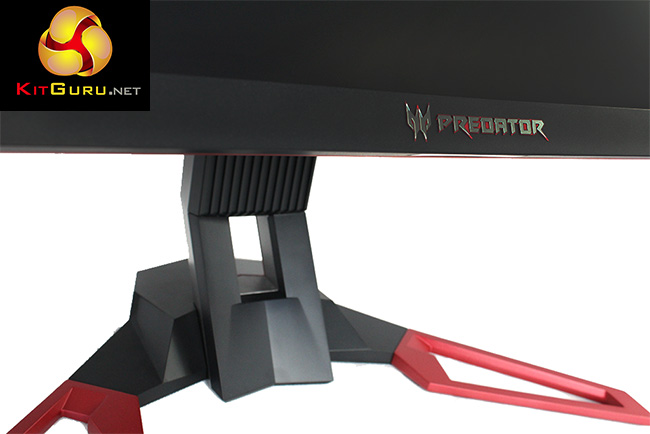There’s much to like about the Acer Predator Z35 Ultra Wide curved display. For starters the interface is the best we’ve seen from the company. They’ve absolutely gone to town with the settings, offering as many as they possibly can think of. A wide range of colour adjustments can be made, along with gaming features and more fun, gimmicky things like crosshairs, flashing LEDs, and the dimming of the power LED.
The new colour scheme works really well. If we had to to find a criticism it would be that things are a little bit complicated, with menus screen after menu screen of settings. While everything is in the logical places, its all a bit overwhelming.
The physical design is also light years ahead of previous Acer displays. Both the XB270HK and XB280HU used glossy black plastic with a rather cheap feel to it that undermined the overall display quality. But the Z35 has a much more updated, premium feel to it.
It’s a bit of a shame, then, that desktop picture quality is the one area where the Z35 doesn’t really impress, and that is entirely due to the use of VA panel technology. While viewing angles should theoretically match IPS, in practice, they don’t quite. This is all rather subjective, since our colorimeter results come out well, but next to an IPS panel, the Z35 really doesn’t look as bright or vivid at all. It’s absolutely noticeable.
Then there’s the resolution. On the desktop, everything is just too big and pixelated for comfort. It’s the same effect as when you see a 27-inch 1080p screen. For that screen size, 1440p is what we consider the perfect native resolution, and ultra-wide, curved displays like the Z35 would be better with a 3,440 x 1,440 resolution.
The sound too, is not very good. At one time, you could completely disregard any built-in sound in a monitor, it was that bad. But things are getting better now, we’ve heard audio from displays that could at least rival living room televisions. In the Acer Predator Z35, the sound is clear enough, but it notably lacks the oomph you get from some display audio, and at loud volumes it really struggles. We’ve heard better.
So with these pros and cons in mind, is the Acer Predator Z35 worth buying? It depends on your priorities. At 200Hz, with G Sync enabled, and a suitably powerful PC to drive 200fps frame rates, it’s a very smooth gaming experience. But most people don’t spend all day playing games, and on the desktop the experience is worse than other displays around the same price point, due to the somewhat poor image quality.
Crucially, we can’t see much difference between G-Sync at 200Hz and 144Hz. Of course, some gamers will absolutely think they can, and they could be right, but the law of diminishing returns certainly plays a part here, and the leap between 144Hz and 200Hz is less noticeable than the one between 60Hz and 120hz.
Weighing this all up, and given that many 21:9 curved IPS displays, including Acer’s own Predator X34, are capable of refresh rates beyond 60Hz at either a similar price or only slightly more expensive than the Z35, while offering a better native resolution, we’d opt for one of them instead.
You can buy the Acer Predator Z35 Ultra Wide curved display from Overclockers UK for £799.99 inc vat HERE.
Discuss on our Facebook page, over HERE.
Pros:
- Comprehensive OSD.
- G-Sync up to 144Hz.
- G-Overclocks up to 144Hz.
Cons:
- Low native resolution.
- Picture quality notably one step behind IPS.
Kitguru Says: There’s an audience for the ultra-high refresh rate on the Acer Predator Z35, and it gets a lot right, with a great design and menu system, but we’d choose a 100Hz IPS display over the Z35 for the higher resolution and clearly superior image quality.
 KitGuru KitGuru.net – Tech News | Hardware News | Hardware Reviews | IOS | Mobile | Gaming | Graphics Cards
KitGuru KitGuru.net – Tech News | Hardware News | Hardware Reviews | IOS | Mobile | Gaming | Graphics Cards





Under Specifications you have this listed as 2560×1440, “Native resolution: 2,560 x 1,440”
This monitor has worse pixel response time at 200Hz than the acer and Asus 1440p monitors do at 144hz. It’s tragic. Had the potential to be a great monitor.
thanks, we fixed that error.
That tiny resolution on that size of panel seems bizarre.
Get the LG 34MU98-W its great and works.
great design, but poor panel.